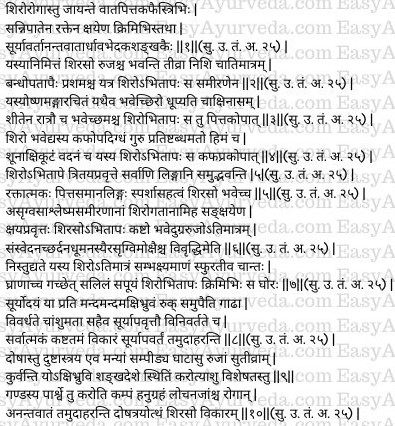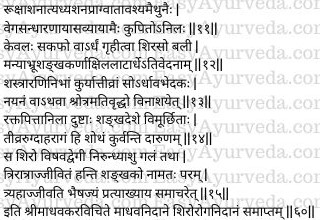Madhava Nidana Chapter 60 Shiro Roga Nidanam

This article explains Madava nidana 60th chapter “Shiro Roga Nidanam”. Causes, pathology and symptoms of Shiro Roga are explained in this chapter. Shiro Roga means diseases of head.

Table of Contents
Shiroroga Bheda
Types of Siroroga based on the causes
The diseases of the head (headache) are caused by individual doshas i.e. aggravated vata, pitta and kapha or by simultaneous vitiation of all three doshas together (sannipataja). They are also caused by rakta (vitiated blood), ksaya (loss, decrease of the tissues) or by krimis (infection from microorganisms). They also manifest by the names Suryavarta, Anantavata, Ardhavabheda and Sankhaka. (1)
Notes – Siroroga is of 11 kinds. They are –
Vataja Siroroga, Pittaja Siroroga, Kaphaja Siroroga, Sannipataja Siroroga
Raktaja Siroroga, Ksayaja Siroroga, Krimija Siroroga
Suryavarta, Anantavata, Ardhavabhedaka, Sankhaka
Read – Pittaja and Kaphaja Shiroroga – Causes, Symptoms, Treatment
Vataja Shiroroga
The symptoms of headache caused by increased vata are –
- sudden appearance of severe headache without any apparent cause,
- headache being more severe at night (gets worse at night)
- gets reduced (relieved) by applying tight bandage and fomentation (warm comforts) (2)
Pittaja Siroroga
The symptoms of headache caused by increased pitta are –
- the head of the patient feels hot as if his head is enveloped by burning charcoal
- feeling as if smoke is coming out of the eyes and nose
- gets relieved with cold comforts and at night time (3)
Kaphaja Shiroroga
The symptoms of headache caused by increased kapha are –
- the head becomes coated with kapha (feeling as if the head is full or is coated with kapha)
- heaviness of the head
- tightness of the head
- coldness of the head
- swelling of the face and orbits (region around the eyes) (4)
Sannipataja Shirorog
In the headache caused by all the three doshas increased together, there will be presence of the symptoms of (aggravation of) all the three doshas at the same time.
Raktaja Siroroga
In the headache caused by (abnormally) increased blood the symptoms will be similar to those of pittaja siroroga. In addition there will be intolerance to touch / tenderness of the head (the person cannot tolerate if his head is touched / will not allow the head to be touched). (5)
Read – Tridoshaja, Raktaja Shiroroga – Causes, Symptoms, Treatment
Ksayaja Siroroga
When there is loss or abnormal decrease of blood, muscle-fat, kapha and vata residing normally in the head a severe form of headache which is difficult to cure manifests with severe pain in the head. This type of headache is called Ksayaja Siroroga. The headache increases by administering of therapies like sudation, emesis, herbal (medicated) smoking, instillation of nasal drops and bloodletting. (6)
Krimija Siroroga
The symptoms of headache caused by krimis (infection by microorganisms) are –
- excessive and constant pricking pain in the head,
- a feeling as if the head is being eaten away from inside
- feeling of pulsations or movements within the head
- watery discharges mixed with pus flowing out of the nose
This headache is said to be dreadful in nature. (7)
Read – Kshayaja and krimija Shiroroga – Causes, Symptoms, Treatment
Suryavarta
The headache which starts at sunrise and the pain gradually increases and spreads to involve the eyes and eyebrows, which gradually increases in severity as the sun reaches its peak (ascent – upward movement of the sun, towards noon) and gradually decreases with the descent of the sun i.e. sunset is called as Suryavarta or Suryapavarta. It is a troublesome (dreadful) disease and is caused by all the three doshas (undergoing increase together). (8)
Read – Suryavarta Shiroroga – Causes, Symptoms, Treatment
Anantavata
All the three doshas (vata, pitta and kapha) which have undergone excessive increase together get lodged (invade) and troubles (pain) in the nape of the neck and produce severe pain at the back of the neck. This pain quickly spreads to the eyes, eyebrows and temples and gets localized therein. This will lead to throbbing (pulsation) on the sides of the cheek bones, stiffness of the lower jaw and many diseases of the eyes. This disease of the head caused by simultaneous vitiation of all the three doshas is known as Anantavata. (9-10)
Read – Anantavata Shiroroga – Causes, Symptoms, Treatment
Ardhavabheda

Causes of Ardhavabheda – Excessive indulgence in (eating) dry foods, too much food frequently, habit of eating food before the previously consumed food is properly digested (eating in presence of indigestion), exposure to heavy breeze coming from the east direction, excessive exposure to snowfall, excessive indulgence in sexual intercourse, habit of suppressing the natural urges, excessive physical exertion and excessive indulgence in physical exercises are the causative factors which cause increase of vata and subsequent manifestation of Ardhavabhedaka.
Pathogenesis – The above said etiological factors would cause abnormal increase of vata. This vata, either alone or gaining strength due to its association with kapha, would invade half the portion of the head and cause the disease Ardhavabhedaka.
Symptoms of Ardhavabhedaka – Ardhavabhedaka is marked by severe pain in the sides of the neck, eyebrows, temples, ears, eyes and forehead of any one side i.e. left or right side. The pain of Ardhavabhedaka is very severe. The person feels as if his head is being cut by a sharp weapon or being burnt by fire or being churned by a churner. If the disease progresses, it will also cause destruction of the functions of eyes or ears.
This disease is called as Ardhavabhedaka. (11-13)
Read – Ardhavabhedaka Shiroroga – Causes, Symptoms, Treatment
Sankhaka
Abnormally increased rakta (blood), pitta and vata get lodged and mixed with each other in the temples and would cause severe pain, burning sensation and reddish swelling therein (in the temples). This swelling having the intensity and velocity (as powerful as) of a life threatening poison quickly causes obstruction in the head and neck and takes away the life of the person within three days. This disease is known as Sankhaka.
Read – Shankaka Shiroroga – Causes, Symptoms, Treatment
By chance if the patient survives even after three days (many times the patient will not survive after three days), it should be treated by considering (announcing) that it is incurable (treating in refusal). According to Master Videha, the treatment of Sankhaka should be done in refusal (announcing that it is difficult to cure or incurable) within three days. After three days this disease becomes incurable. (14-15)
Thus ends the chapter on Siro Roga Nidanam in Madhava Nidana text written by Acharya Madhavakara.










